Morgan Motor Company
 | |
| Private | |
| Industry | Motoring |
| Founded | 1910 |
| Founder | H.F.S. Morgan |
| Headquarters | Malvern, Worcestershire, England |
Key people |
Chairmen: H.George Morgan (1910—1933) H.F.S. Morgan (1910–1959) Peter Morgan (1959–2003) Alan Garnett (2003—2006) Andrew Duncan (2013—2016) |
| Products | Motor cars |
| Revenue | (All divisions) £26 million (UK Companies House 2015 Financials) |
| Owner | Morgan Family (100%) |
Number of employees | 177 (UK Companies House 2015 Financials) |
| Website | Morgan-Motor.co.uk |
The Morgan Motor Company is a family-owned British motor car manufacturer that was founded in 1910 by Henry Frederick Stanley Morgan.
Morgan is based in Malvern Link, an area of Malvern, Worcestershire and employs 177 people. Morgan has stated that they produce "in excess of 1300" cars per year,[1] all assembled by hand. The waiting list for a car is approximately six months, although it has been as long as ten years in the past.
A visitor centre and museum feature exhibits about the company's history from Edwardian times until the present day, developments in automobile technology, and a display of automobiles. There are also guided tours of the factory.
Company history
.jpg)
.jpg)
Henry Frederick Stanley Morgan, generally known as "HFS", was an employee of the Great Western Railway, who bought his first car in 1902 at the age of 21. In 1904, he left his railway job and co-founded a motor sales and servicing garage in Malvern Link. In 1909 he designed and built a car for his own use. He began production a year later and the company prospered. Morgan continued to run it until he died at age 77 in 1959.[2]
Peter Morgan, son of HFS, ran the company until a few years before his death in 2003. He was replaced as chairman by Alan Garnett, a non-family director, from 2003 to 2006. After Mr. Garnett's resignation, a four-man management team was set up.
Charles Morgan, son of Peter, Matthew Parkin, Tim Whitworth, Steve Morris made up the new management team, and in 2010, after Mr. Parkin's resignation, Charles Morgan was named Managing Director. However, in January 2013, Charles Morgan was removed as Managing Director, replaced by Steve Morris. He continued as strategy director until October 2013 when he was removed both as an employee, and from the Board of Directors.[3][4][5]
At the end of 2013, the shareholders appointed Andrew Duncan, a local solicitor, as the Chairman. In 2016, he resigned as Chairman and company director and was replaced as Chairman by a new director by Dominic Riley, a business turnaround expert.
Early cars: three-wheelers and 4-4s
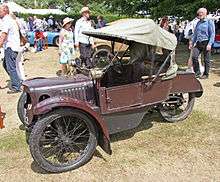

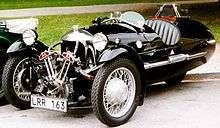
The early cars were two-seat or four-seat three-wheelers, and are therefore considered to be cyclecars. Three-wheeled vehicles avoided the British tax on cars by being classified as motorcycles. Competition from small cars like the Austin 7 and the original Morris Minor, with comparable economy and price and better comfort, made cyclecars less attractive.
V-Twin three-wheelers (1911–1939)
H.F.S. Morgan's first car design was a single-seat three-wheeled runabout, which was fabricated for his personal use in 1909. Interest in his runabout led him to patent his design and begin production. While he initially showed single-seat and two-seat versions of his runabout at the 1911 Olympia Motor Exhibition, he was convinced at the exhibition that there would be greater demand for a two-seat model.[6] The Morgan Motor Company was registered as a limited private company only in 1912 with "H.F.S." Morgan as managing director and his father, who had invested in his son's business, as its first chairman.[2]
Morgan established its reputation via competition such as winning the 1913 Cyclecar Grand Prix at Amiens in France. This became the basis for the 'Grand Prix' model of 1913 to 1926, from which evolved the 'Aero', and 'Sports' models.[7]
These models used air-cooled or liquid-cooled variations of motorcycle engines.[8] The engine was placed ahead of the axis of the front wheels in a chassis made of steel tubes brazed into cast lugs.[9]
The V-Twin models were not returned to production after World War II.
F-Series three-wheelers (1932–1952)
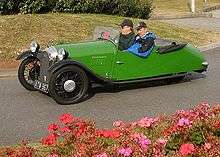
The Morgan F-4 was introduced in 1933 at the Olympia Motor Cycle Show.[10] The F-4 had a new pressed-steel chassis[9] the four-cylinder Ford Sidevalve engine used in the Model Y, and a four-seat body.[7][10] The F-4 was supplemented by the two-seat F-2 in 1935 and the more sporting F Super, with cycle-type wings and louvred bonnet tops, in 1937. Production of the Ford-engined three-wheelers continued until 1952.[7][10]
4–4
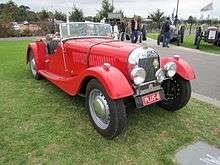
Morgan's first four-wheeler was the 4–4, for four-cylinder engine and four wheels. The first production 4-wheeled Morgan was released to the public in 1936 and is known as the Morgan 4–4 Series 1. Three-wheeler production continued alongside the 4–4 until 1952.
Postwar cars
Morgan +4
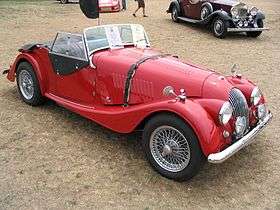
The Morgan +4 was introduced in 1950 as a larger-engined ("plus") car than the 4–4. The +4 used the 2088 cc Standard Vanguard engine, while the 4–4 used a Standard Special 1267 cc engine (1950–58). Later +4s used Triumph TR2–TR4 engines (1954–1969). Plus 4 production was suspended in 1969 but brought back in 1985 with a Fiat engine (1985–1988) and then a 4-cylinder Rover engine (1988–2000). Production was again suspended and the Plus 4 returned once more in 2004 with a 155 bhp (116 kW; 157 PS) Ford 4-cylinder.
Morgan +4+
A version of the +4, designated the +4+, was made from 1964 to 1967 with a contemporary fibreglass coupe body. The light weight and reduced drag characteristics improved the performance of the +4+ over the regular +4 in every aspect. However, the traditional Morgan enthusiasts did not embrace this departure from Morgan custom, and mainstream enthusiasts did not embrace the seemingly archaic +4 chassis. Only 26 +4+ cars were built.
Limited edition Plus 4 model is re-introduced in the year 2014 as Plus 4 Super Sports where only 60 cars are made available and each car will be right hand drive.
Morgan 4/4

The 4–4 was replaced by the 4/4 in 1955. The 4/4 now uses the +8 chassis and a Ford engine.
Morgan +8
Faced with the decreasing availability of large four-cylinder engines for use in their +4 models, Morgan began to install the recently available Rover V8 engine in their cars in 1968, giving these cars the model designation "+8".
The engine displacement jumped from the 2.3 L of the Triumph TR4 engine to 3.5 L, then 3.9 L (1990), 4.0 (1998–2004) with an optional 4.6L (1996–2000) all based on the same Land Rover block. However, the V-8 was no longer than the Triumph. These features made the +8 accelerate much more quickly than the early +4 and also improved its road-holding capability.
Horsepower (143–204 bhp), weight and performance varied with emission and structural laws through its history. In its final form, the GEMS Land Rover V8 produced 190 hp (140 kW). Thus powered, the car could accelerate from 0–60 mph in 5.6 seconds.
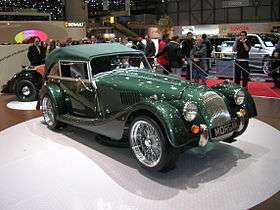
Roadster
In 2004, Morgan came out with a traditional styled model to replace the departing Plus 8. The Mk I Roadsters with the Ford UK Mondeo V6 produced 223 bhp (166 kW, 226 PS) at 6150 rev/min. It had a Getrag gearbox with direct drive in 5th with a 3.08 axle ratio. Later Marks had a Ford gearbox with direct drive in 4th with a 3.73 axle ratio. The overall gearing is virtually the same. The later Roadsters were powered by a Ford UK Mondeo V6 producing 204 bhp (152 kW; 207 PS). In 2007, the Mondeo engine was replaced by a U.S.-specification version of the same engine in the Roadster II. In 2011-12, the engine was replaced by the 3.7 Duratec Cyclone engine and output increased to 280 bhp (209 kW; 284 PS). The company calls this latest model the Roadster 3.7.
Morgan Aero 8 (Series I-V)
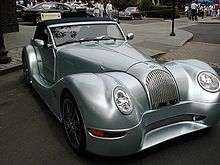
In 2000, the Morgan Aero 8 was introduced and, as always, the wooden body substructure was ash. (Contrary to popular myth, however, the chassis is metal; aluminium for the Aero 8.) The Aero 8, with a BMW V8 engine in a car weighing less than a BMW Z4 and considerably less than a BMW M3, (though more than traditional Morgans) is even faster than the Plus 8, delivering what Autoweek magazine termed supercar performance. The newest Aero 8 (series V), presented in March 2015, puts out 367 hp (274 kW) at 6100 rpm with the company suggesting a top speed of over 170 mph (270 km/h). Due to the Aero 8's light weight it can do 0–62 mph (100 km/h) in 4.5 seconds.[11]
During its customer production lifetime (2002–2009), the Aero was configured in five official versions, (I,II, III, IV, the Aero America and V) with mild variations in styling, engines, transmissions, braking and suspension. The company canceled the model in 2009 but relaunched it in 2015 for 2016 deliveries. The year of highest production for any Aero variation was 2002.
Morgan AeroMax

The Aero was followed by the Aeromax, a limited edition of 100 units produced between 2008 and early 2010. The Aeromax was a coupé variation of the Aero 8. Customers have included Richard Hammond, Rowan Atkinson and Paul O'Grady.
Morgan Aero SuperSports
The Morgan Aero SuperSports is a targa-roofed version of the AeroMax, sharing its bonded aluminium chassis and lower bodywork with the coupe.[12] It was launched at the 2009 Pebble Beach car show in California. Its cancellation was announced in March 2015.
Morgan Aero Coupe
The Morgan Aero Coupe is a hard top version of the Aero SuperSports, sharing its bonded aluminium chassis, bodywork, suspension, and engine. It was launched at the end of 2011. It is not available in the USA. Its cancellation was announced in March 2015.
Morgan Aero Plus 8
The new Morgan Plus 8 is a classic body version of the Aero SuperSports and Aero Coupe, sharing their bonded aluminium chassis, bodywork, suspension, and engine. It was launched at the end of 2011. It is not available in the USA.
Morgan Plus E
The Morgan Plus E was an experimental electric version of a classical Morgan, a joint project of Morgan with Zytek and Radshape (Radshape Sheet Metal Ltd.),[13] funded by the UK government. It was displayed at the 2012 Geneva Motor Show.[14][15]
Morgan Eva GT
Based on the same chassis as the Aero Supersports, the Eva GT will be a 2+2 grand tourer, and as such it is longer in the body. The Eva GT will use BMW N54 twin-turbo straight-6 producing 302 bhp, this is Euro-6 emissions compliant. Shown at Pebble Beach in clay in 2010 and expected to go on sale in 2012, deposits have been taken since 2010. At the end of 2011, Morgan announced that it will use new magnesium technology for the body and therefore it will not be re-presented until 2014 with deliveries after that. In 2013 dealers confirmed that the EvaGT had been cancelled.
Morgan 3-Wheeler
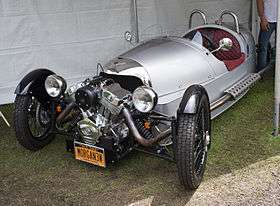
The Morgan Motor Company announced that they would launch the "3 Wheeler" in 2011[16][17][18][19] at the Geneva Motor Show.[17][18] The 3 Wheeler was initially said to have a Harley-Davidson Screaming Eagle V-twin engine and a Mazda 5-speed manual transmission,[16][17][18][19][20] and was estimated to deliver 115 horsepower (86 kW)[16][18][19][20] at the rear wheel.[19][20] However, there was a surprise when the prototype that was shown at Geneva had an S&S engine. Production three-wheelers turned out to have S&S engines.[21][22] The kerb weight was originally estimated to be less than 500 kilograms (1,102 lb),[16][17][18][20] but the final weight was tested at 550 kg. The acceleration from zero to 60 miles per hour (97 km/h) was estimated by Morgan as 4.5 seconds, with an (estimated) top speed of 115 miles per hour (185 km/h).[16][17][18][19][20] The three-wheeler is to be homologated as a motorcycle in the United States.[16][20] The company states that 850 deposits have been taken since the announcement in 2011. Customer deliveries began in Europe in February 2012. USA deliveries are not expected before June 2012, when the first imported three-wheeler was displayed in New York City and at the Greenwich Concours d'Elegance. The Morgan 3 Wheeler was featured in a Series 18 episode of UK motoring show Top Gear where presenter Richard Hammond picked the Morgan 3 Wheeler in a comparison of track-day cars. The 3 Wheeler won the "Not-A-Car of the Year 2011" in Top Gear.
Availability in the United States

For part of the 1950s and 1960s, the USA provided the company with its largest market worldwide, taking up to 85% of all production.[23] This ended with the first wave of US safety and emission regulations in 1971. For many years (1974 to 1992), all Morgans imported into the United States were converted to run on propane as fuel to pass the U.S. emissions regulations. However, this conversion, along with bringing the cars into compliance with U.S. vehicle safety legislation, was carried out by the dealership, and not by the factory, making the cars grey market vehicles.[24]
However, when the Rover Group re-certified their V8 engine for use in the Range Rover 4x4 sold in the U.S., Morgan was able to use the same engine for a fully U.S.-compliant stock Morgan from 1992 to 1996, and again from 1998 to 2004. In 2005, the engine was replaced with the U.S. version of another traditionally shaped model (with a V6), called the Roadster.
In 2002, Morgan centralised its international compliancy development and regulatory interaction in-house. In 2005, its right to import its classic models ceased when supplies of its necessary airbag were exhausted and no replacement was developed. In 2006, a request for an airbag exemption to the U.S. National Highway Traffic Safety Administration was refused, and the import of classic Morgans ceased.[25]
In 2005, the new Morgan Aero 8 model (versions 2 and 3) received a three-year exemption from rear impact non-compliance,[26] along with a separate exemption for compliance with "advanced airbag requirements".[27] The rear-impact exemption lapsed in May 2008 without further application. Morgan has indicated to its U.S. dealers that it plans to re-apply for US certification for some model at as yet an undetermined date in the future.
In April 2012, the new Morgan 3 Wheeler was show-cased at the New York International Auto Show, at the Jacob Javits Center, by Bobby Singh and Gideon Lang-Laddie of Manhattan Motorsports. This was the first time in 10 years that Morgan had had a presence at the largest of the American car shows and was the first US specification Morgan 3 Wheeler in the USA. The Morgan 3 Wheeler was voted one of the "Hottest Cars Of The Show" by G4TV.[28]
In May 2012, Manhattan Motorsports took delivery of Charles Morgan's Superdry edition Morgan 3 Wheeler and prepared it for its first major American trial. This vehicle was driven across the States, from New York to Los Angeles by Charles Morgan and his wife, covering 3000 miles, in the Gumball 3000. At the end of the seven-day drive, the Morgan 3 Wheeler was awarded the "Spirit of Gumball" prize.
General characteristics

In spite of their traditional design, Morgans have always had sporting or "sports car" performance, due to their extremely low weight.
Among their enthusiasts, Morgans are affectionately known as "Moggies".
Suspension
H.F.S. Morgan's 1909 Runabout used sliding pillar suspension, an independent front suspension system with each front wheel mounted on a stub axle able to slide up and down a fixed pillar that also acts as the kingpin and supported by a spring and external shock absorber (damper). One advantage is reduced unsprung weight, theoretically allowing the tire and wheel to better respond to road surface irregularities. The Morgan system is described as an 'inverted' sliding pillar, as the pillar is fixed and the hub carrier slides over it. Earlier systems had the wheel carried on the pillar, sliding through a bush on the axle.
Morgan used developments of this suspension system throughout its existence and it is still used on Morgan's "classic" line, although not on the Aero 8 or its derivatives.
Models
- 1909 Runabout
- 1911–1939 V-Twin 3-wheeler
- 1932–1952 F-Series 3-wheeler
- Since 1936 4/4 Two-Seater and Four-Seater
- 1950–1969 Plus 4
- 1964–1967 Plus 4 Plus
- 1968–2004 (and 2012-) Plus 8
- 1985–2000 Plus 4
- 2001–2009 Aero 8
- 2004-2012 V6 Roadster
- Since 2005 Plus 4
- 2006-pending Morgan LIFEcar
- 2008–2009 AeroMax
- Since 2009 Morgan 4/4 Sport
- 2010–2015 Aero SuperSports
- 2010–cancelled Morgan Eva GT
- 2011–cancelled Morgan Plus E
- 2011-2012 Morgan Plus 4 Supersports
- 2011–present Morgan Anniversary 4/4
- 2012-2015 Aero Coupe
- 2012–present Morgan 3 Wheeler
- 2012–present Morgan Aero Plus 8
- 2012–present Roadster 3.7
- 2015- Morgan Aero 8
Motorsports
Morgan cars can be found in many areas of motorsport, from club and historic racing to more prominent examples, including the Le Mans 24hr race. A notable Morgan racecar was the Aero 8 GT car that campaigned in 2008 Britcar races and the 2008 Britcar 24hrs at Silverstone, prepared and run by Mark Bailey Racing.
Pescarolo Sport will be rebranding its Le Mans Prototype as a Morgan for the 2012 24 Hours of Le Mans, partly to mark the 50th anniversary of a class victory for a Morgan Plus Four Super Sports at Le Mans.[29]
 |
1928 Morgan Super Aero
1928 Morgan Super Aero at Goodwood Festival of Speed 2009 |
| Problems playing this file? See media help. | |
 |
Morgan Aero Supersports at Goodwood Festival of Speed 2010
|
| Problems playing this file? See media help. | |
In popular culture
- GoMoG's Morgans at the Movies
- Sir John Harvey Jones famously visited the firm in the 1990s BBC documentary series Troubleshooter in which he advised the firm to modernize. The company rejected the advice but made other changes to its processes and has gone on to prosper.[30]
See also
References
- ↑ "About us", Company webpage
- 1 2 Hastings, Harold (30 May 1970). "Sixty years old and thriving". Motor: 28–31.
- ↑ Ping Chan, Szu (18 October 2013). "Charles Morgan describes distress at being ousted from board role". Daily Telegraph. London. Retrieved November 12, 2013.
- ↑ "Charles Morgan removed from world-famous UK car firm". BBC. 31 October 2013. Retrieved November 12, 2013.
- ↑ Massy, Ray (17 October 2013). "Historic British sports car maker Morgan faces backlash after ousting the founder's final family member from the board". Daily Mail. London. Retrieved November 12, 2013.
- ↑ "How The Morgan Began". Morgan3w.de. 1952-07-29. Archived from the original on 2012-03-02. Retrieved 2011-09-17.
- 1 2 3 "The Morgan Three-wheeler Models". Morgan3w.de. Archived from the original on 2012-12-03. Retrieved 2011-09-17.
- ↑ "Engines used in the Morgan Three-wheeler". Morgan3w.de. Archived from the original on 2012-04-08. Retrieved 2011-09-17.
- 1 2 "– Technical Details of the Morgan Three-wheelers". Morgan3w.de. Archived from the original on 2012-07-10. Retrieved 2011-09-17.
- 1 2 3 Hill, Ken (2007) [1996]. "Morgan cars". The Morgan. Shire Series. 327. Princes Risborough, Buckinghamshire, UK: Shire Publications. pp. 13–14. ISBN 978-0-7478-0328-7. Retrieved 2013-02-13.
- ↑ "2006 Morgan Aeromax". Seriouswheels.com. Retrieved 2011-09-17.
- ↑ Morgan Aero Supersports review Retrieved 2010-11-20.
- ↑ news: morgan-plus-e-electric-roadster-modern-battery-in-classic-car at greencarreports.com; Dated Feb 10, 2012, Retrieved 2016-09-11
- ↑ The New Morgan Plus E Retrieved 2014-08-27.
- ↑ something-old-something-new-the-morgan-plus-e at newatlas.com; Dated March 8, 2012, Retrieved 2016-09-11
- 1 2 3 4 5 6 "2011 Morgan Threewheeler". Edmunds Inside Line. Edmunds Inc. Nov 4, 2010. Retrieved 2011-02-19.
- 1 2 3 4 5 Harrison, Sarah-Jayne (3 November 2010). "Morgan 3 Wheeler (2011) first official pictures". Car Magazine. Peterborough, Cambridgeshire, UK: Bauer Media. Retrieved 2011-02-19.
- 1 2 3 4 5 6 Phillips, Tom (4 November 2010). "Morgan revives the Threewheeler". Auto Express. London: Dennis Publishing. Retrieved 2011-02-19.
- 1 2 3 4 5 Constant, Brad (2010-03-11). "Morgan Threewheeler returns after 58-year break". Autoweek. Detroit, MI, USA: Crain Communications. Retrieved 2011-02-19.
- 1 2 3 4 5 6 Miersma, Seyth (November 3, 2010). "First Look: 2011 Morgan Threewheeler". Winding Road. Ypsilanti, MI, USA. Retrieved 2011-02-19.
- ↑ Garrett, Jerry (2011-02-25). "Geneva Auto Show: Morgan 3 Wheeler". The New York Times. Retrieved 2011-03-04.
It was announced to have an 81-horsepower V-twin motorcycle engine built by S & S, the same company that builds motors for so-called Harley clone choppers, and is closely based on late-model Harley-Davidson power plants. However, the UK test the final bhp at 81 bhp.
- ↑ Berkowitz, Justin (March 2011). "Morgan 3-Wheeler - Auto Shows". Car and Driver. Hachette Filipacchi Media U.S. Retrieved 2011-03-04.
This S&S-supplied powerplant is a bit more modern, though: It produces 81 hp, is fuel-injected, and is mated to a Mazda-sourced five-speed gearbox.
- ↑ Laban, Brian. Morgan: First and Last of the Real Sports Cars. London: Virgin Books, 2000, page number not cited.
- ↑ "Reprint of Car & Driver article, January 1977". Morgancars-usa.com. Retrieved 2011-09-17.
- ↑ Federal Register: NHTSA Denial of application for a temporary exemption from air bag provisions of Federal Motor Vehicle Safety Standard No. 208, Occupant Crash Protection.
- ↑ Federal Register: NHTSA Grant of application for a temporary exemption from Part 581 Bumper Standard
- ↑ Federal Register: NHTSA Grant of application for a temporary exemption from FMVSS 208 for Advanced Airbag Requirements
- ↑ Hardiman, Paul. "The New Morgan Three Wheeler". Hagerty.com. Retrieved 2014-03-01.
- ↑ "British Sportscar Maker Morgan to Race LMP2 Car at Le Mans". motortrend.com. 2012-01-23. Retrieved 2012-03-04.
- ↑ "How the troubleshooter's firms fared". BBC. January 11, 2008. Retrieved 2011-10-13.
External links
- The Morgan Motor Company
- Morgan 3 Wheeler site
- Morgan Motor Company Visitors Centre and Museum
- GoMoG Workshop Manual
- Morganatica – A Technical Manual Resource For Morgan Motor Cars
- Morgan Three Wheeler Reborn
- Morgan History Info site
| Wikimedia Commons has media related to Morgan Motor Company. |